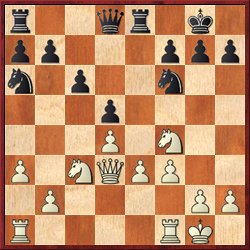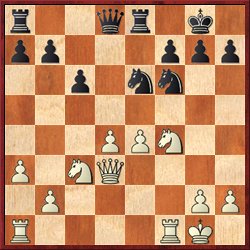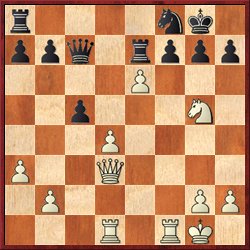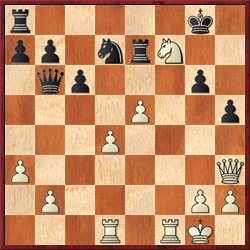Mike Splane had another chess party at his house yesterday, probably about the fourth or fifth one I’ve been to, though I’m not really sure. I felt that this was the most interesting one yet, at least for me. I brought a game that I lost in the recent Reno tournament and received some very good tips on what I could have done better.
As usual, we also played some tandem chess. I’d like to show you a few positions from the game of Gjon Feinstein and Nelson something (White) versus Jan DeJong and Richard Koepcke (Black). The interesting thing about these positions is that they featured some vigorous disagreements between partners (and opponents) on how to properly play the position.
Position 1. Black to move (Jan) played 13. … Nc7. What would be a more dynamic way to play the position?
Position 2. White to play. Gjon played 16. Nxe6. His partner, Nelson, wanted to keep more material on the board with 16. N4e2. Whom do you agree with?
Position 3. White has just played 21. Ne4. Black to move (Jan) played 21. … Qb6. His partner (Richard) wanted to get some counterplay with 21. … c5 instead. What do you think?
Answers.
1. Richard stated very emphatically, “13. … c5 had to be played here.” Not everyone was so sure. After 14. cd Nxc5, Black’s isolated queen pawn is very weak. But on the other hand, White has some weak points, too — the squares b3 and e3. These were direct results of White’s last two moves, 12. a3 and 13. f3.
Nelson, who had played those two moves, was eager to justify them by proving that 13. … c5 is nothing to be afraid of. After 14. dc Nxc5 he advocated 15. Qb5, saying, that’s a knight en prise!” (In other words, White does not have to worry about 15. … Rxe3 because of 16. Qxc5.)
However, I think that Richard was right on this one. After 15. Qb5 Black just defends the knight with 15. … Rc8. Now 16. b4? would be a mistake after 16. … a6! 17. Qe2 (the only square left for White’s queen!) Nb3, winning the exchange. I think that the most dangerous way to play for White is 16. Rad1, but Black seems fine after 16. … Rxe3 17. Nfxd5 Nxd5 18. Nxd5 Qe8! (diagram)
Position after 18. … Qe8 (analysis).
This neat little move sidesteps any unpleasant threats on the d-file, and doesn’t give White any time to take on e3. To me, this line shows that the weakness of White’s e-pawn just balances the weakness of Black’s d-pawn, and also that White’s queen on b5 is as much of a target as it is an attacker.
2. Strategically speaking, Nelson is right. As the player with more space and more attacking chances, White would like to keep more attackers on the board. However, you have to remember that chess isn’t just about strategy. After 16. Ne2? Nc5! Black simply wins the e-pawn.
3. Ordinarily I would say that Richard’s instinct is right — just as it was eight moves earlier, … c5 looks like a good way to challenge White’s center.
However, Black’s king is a lot less safe than it was before. After 21. … c5 Nelson suggested 22. Ng5!, and it seems to me that this gives White a decisive attack. The main point is 22. … Nf8 23. e6!
Position after 23. e6! (analysis).
After 23. … fe? White wins with 24. Rxf8+! Kxf8 25. Qxh7. (I’ll let you work out the rest.) If 23. … f6 24. d5 White threatens d6, with a nasty fork of the queen and rook. Gjon came up with the nice idea of 24. … c4, with the idea of 25. Qd4? fg! 26. d6 Nxe6 and Black is fine. However, after 25. Qe3! fg 26. d6 Rxe6 27. Qxe6+ Nxe6 28. dc Nxc7 Black has gotten two pawns for the exchange, but White can double his rooks on the seventh rank, and I think it will be very hard for Black to hold.
Since Richard’s 21. … c5 doesn’t seem to work, Jan’s 21. … Qb6 doesn’t seem all that bad! At least it gives White something to think about. White doesn’t have time for 22. Nd6 because of 22. … Nxe5. If White unpins the d-pawn with 22. Kh1, now 22. … c5 is a lot better than before. Instead Nelson played 22. Ng5, which looks right. After 22. … Nf8, though, I think White would still have had something to prove. Ihstead Jan erred with 22. … g6? and after 23. Qh3 h5 24. Nxf7! White went on to win.
Position after 24. Nxf7! (game)
There’s a lesson here. Paul Keres once wrote that “you won’t get mated with a knight on f8.” While that may be a bit of an exaggeration, a castled king with a knight on f8 is usually safer than a king with the loosey-goosey pawn formation f7-g6-h5.









{ 2 comments… read them below or add one }
Paul Keres once wrote that “you won’t get mated with a knight on f8.â€
I think that was GM Bent Larsen
Hi Dana,
I’m happy to see that you had a good time at my chess salon. I’ve lost track of the number too; my best guess is this was number 7 or maybe even number 8.
Nelson’s last name is Wiggins. Jan DeJong prefers to go by his initials, JL.
I thoroughly having you as my partner in the tandem game we played. Gjon Feinstein and I looked at that game and he discovered a forced win for our side that we both missed.
I hope you continue coming to the events and showing your games. You have an interesting style and I’m sure the other players are learning as much from you as you are learning from them.
Mike Splane